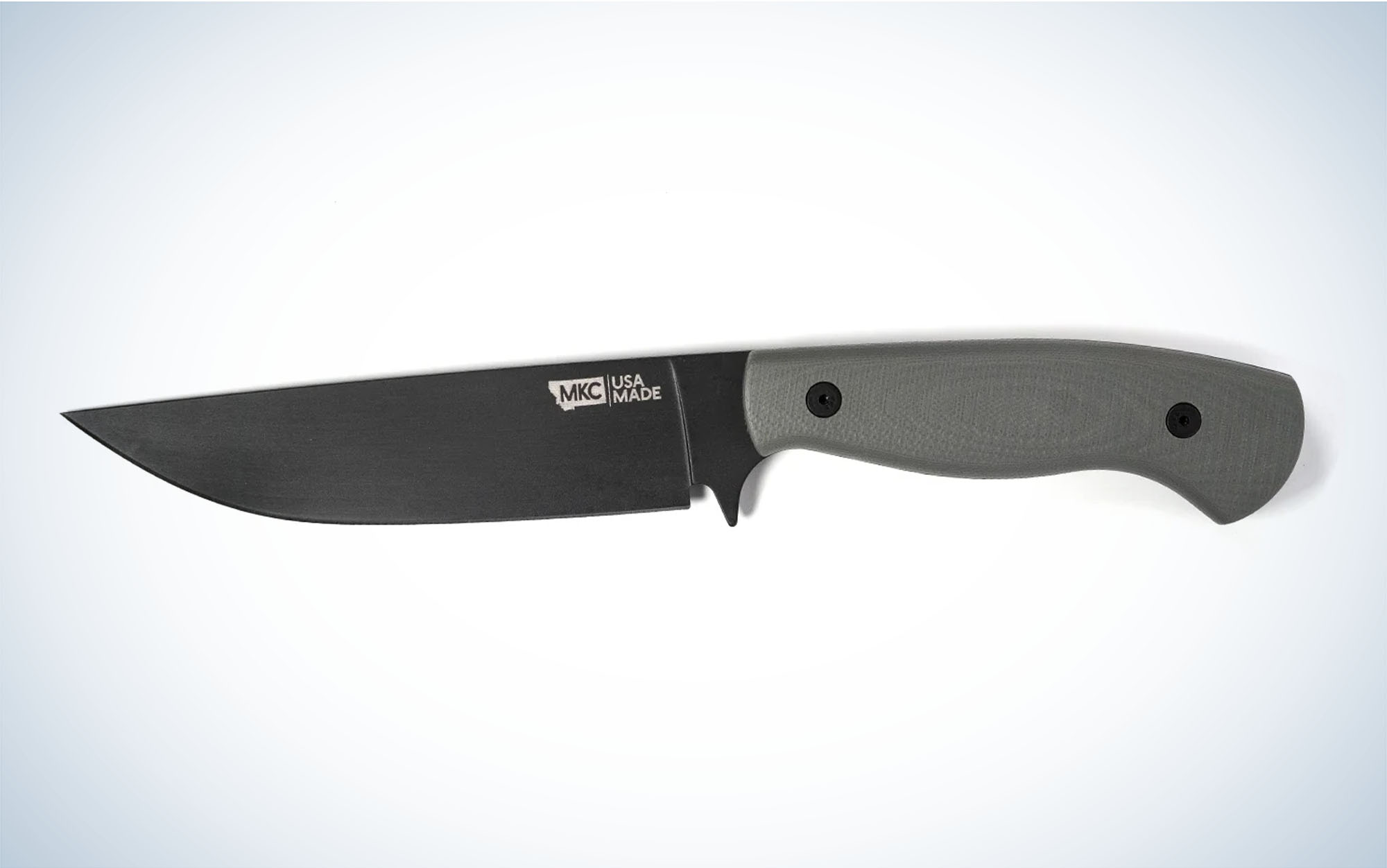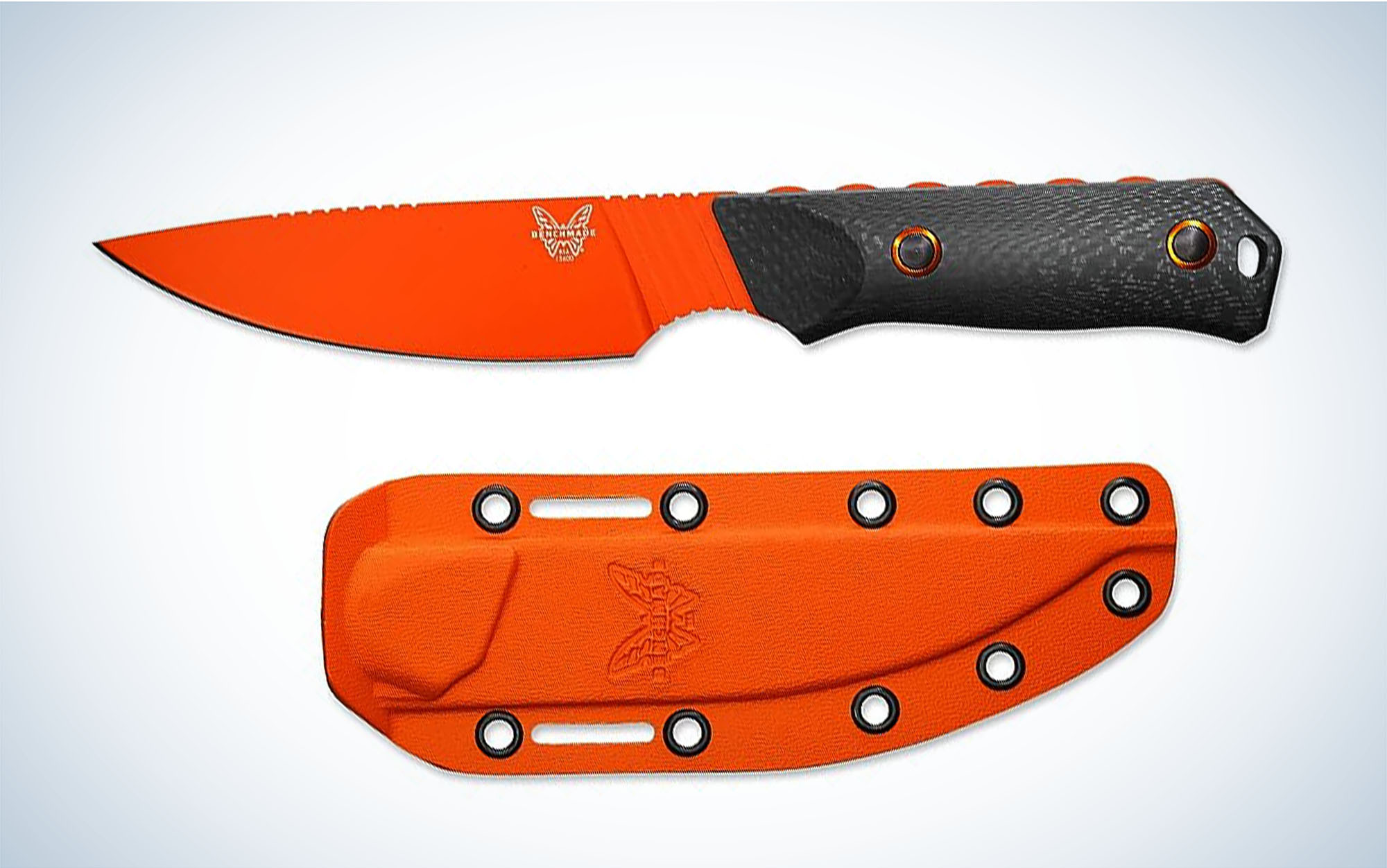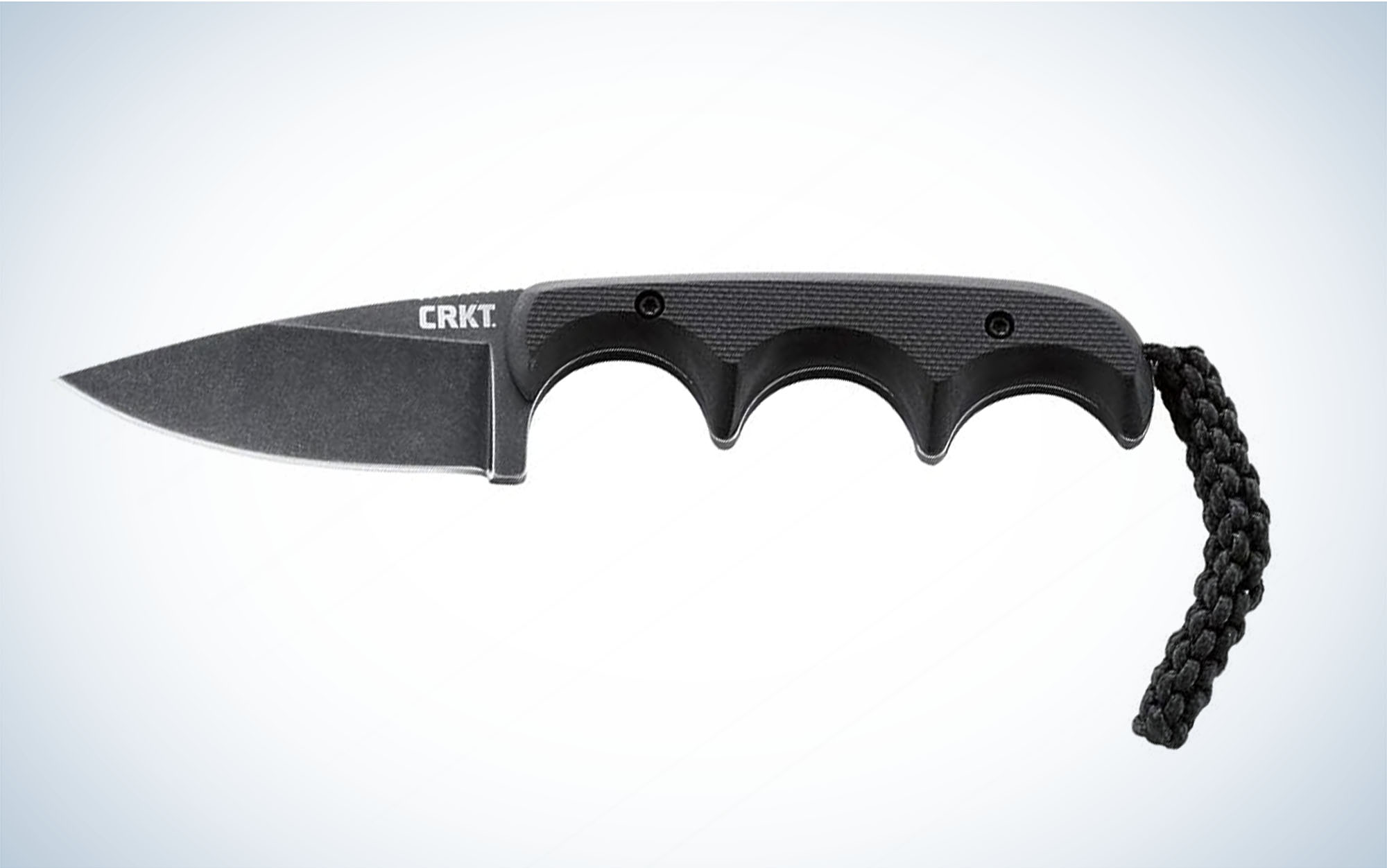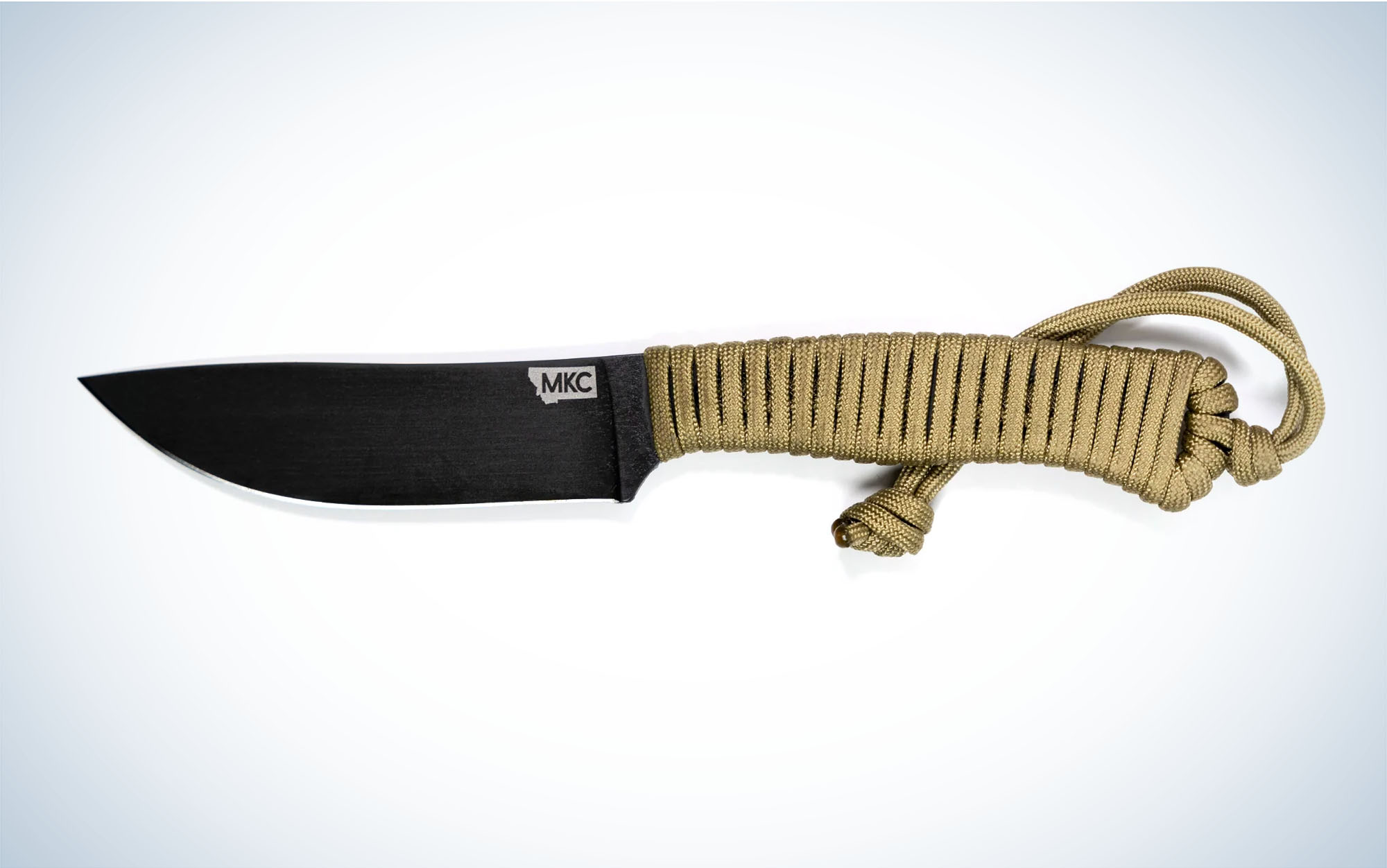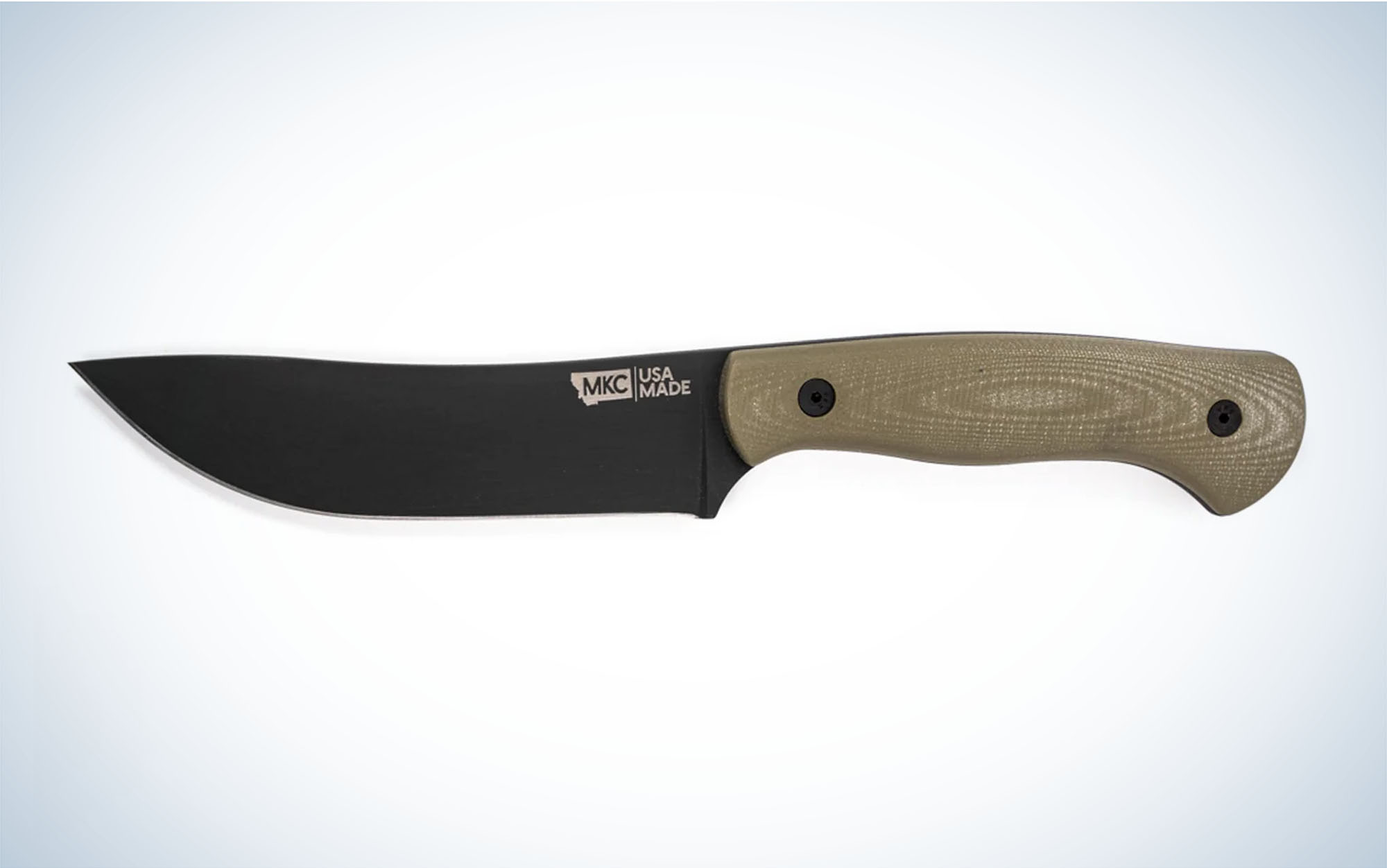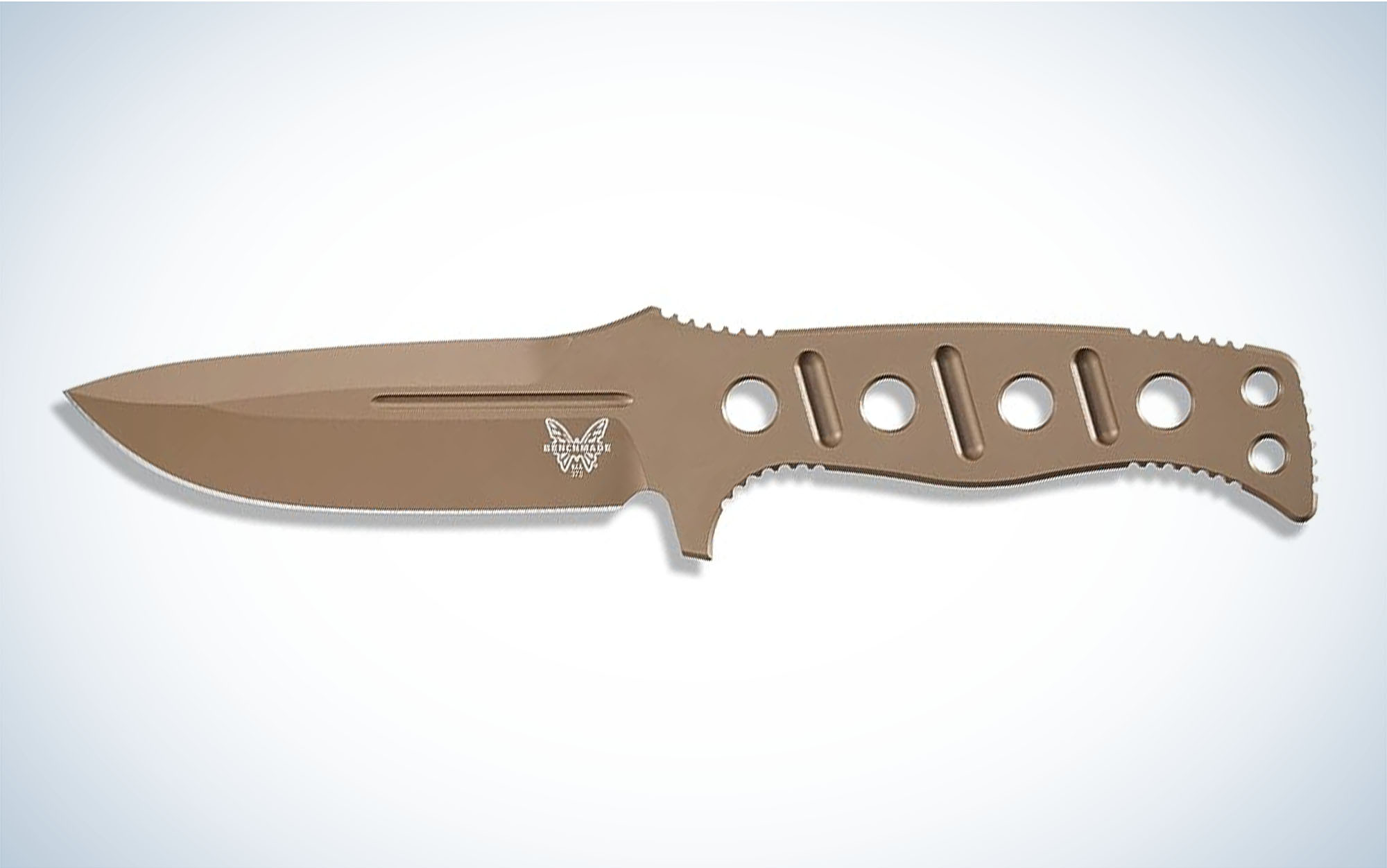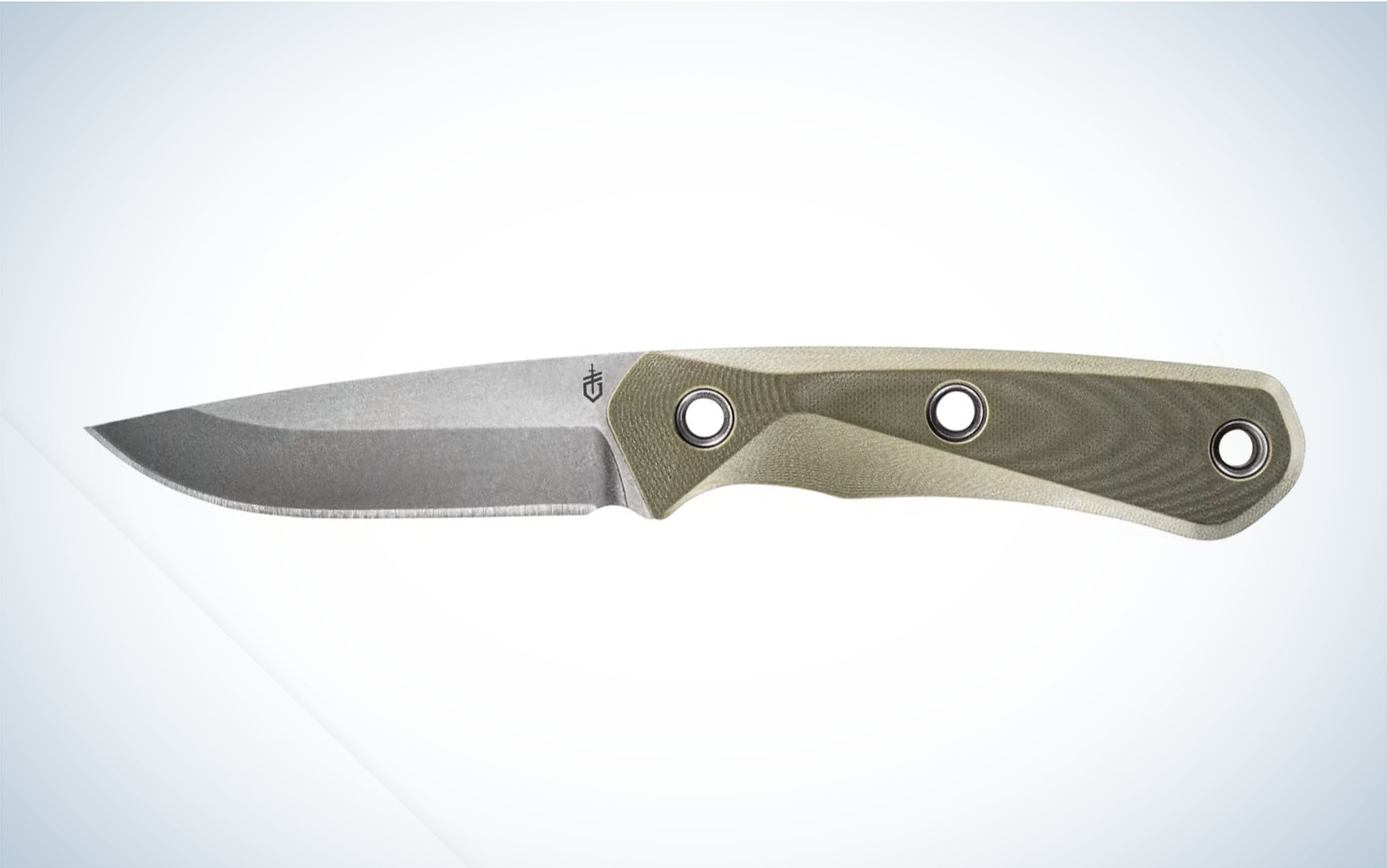We may earn revenue from the products available on this page and participate in affiliate programs. Learn More ›
Published Sep 7, 2023 2:44 PM
Shopping for a fixed blade knife presents a huge hurdle: There are over 10,000 options on just one of the online knife retailers. Of course, that includes all color and steel variants for a given model, and not all are in stock, but still, that’s a lot of blades. Which one do you get? Where do you spend your hard-earned money? What features do you need?
The fact is that there are dozens and dozens of good fixed blade knives out there. With the help of some friends and fellow knife nuts, I picked the best fixed blade knives to showcase top options and I put them through a series of cutting tests. I could have easily tripled the number of blades on this list and still not have covered all the great knives available today. So, if you’re a knife enthusiast, you’ll most likely be mad that one of your favorites didn’t make the list. But, if you’re searching for an upgrade or a fixed blade for a specific task, these reviews will point you towards some of the best the market has to offer.
How We Tested the Best Fixed Blades
Fixed blade knives are made to cover a really wide range of tasks and obviously have big design differences because of that. Some are beefy so they can handle heavy use and emergency situations, and some are designed to be amazing slicers or ultralight for backpacking and hunting. Some are small for easy carry and concealment, and some are larger for light chopping and better reach. I wanted to keep this test about knives that do knife stuff, so big choppers and super thick “sharpened pry bars” were left out.
Cut Tests
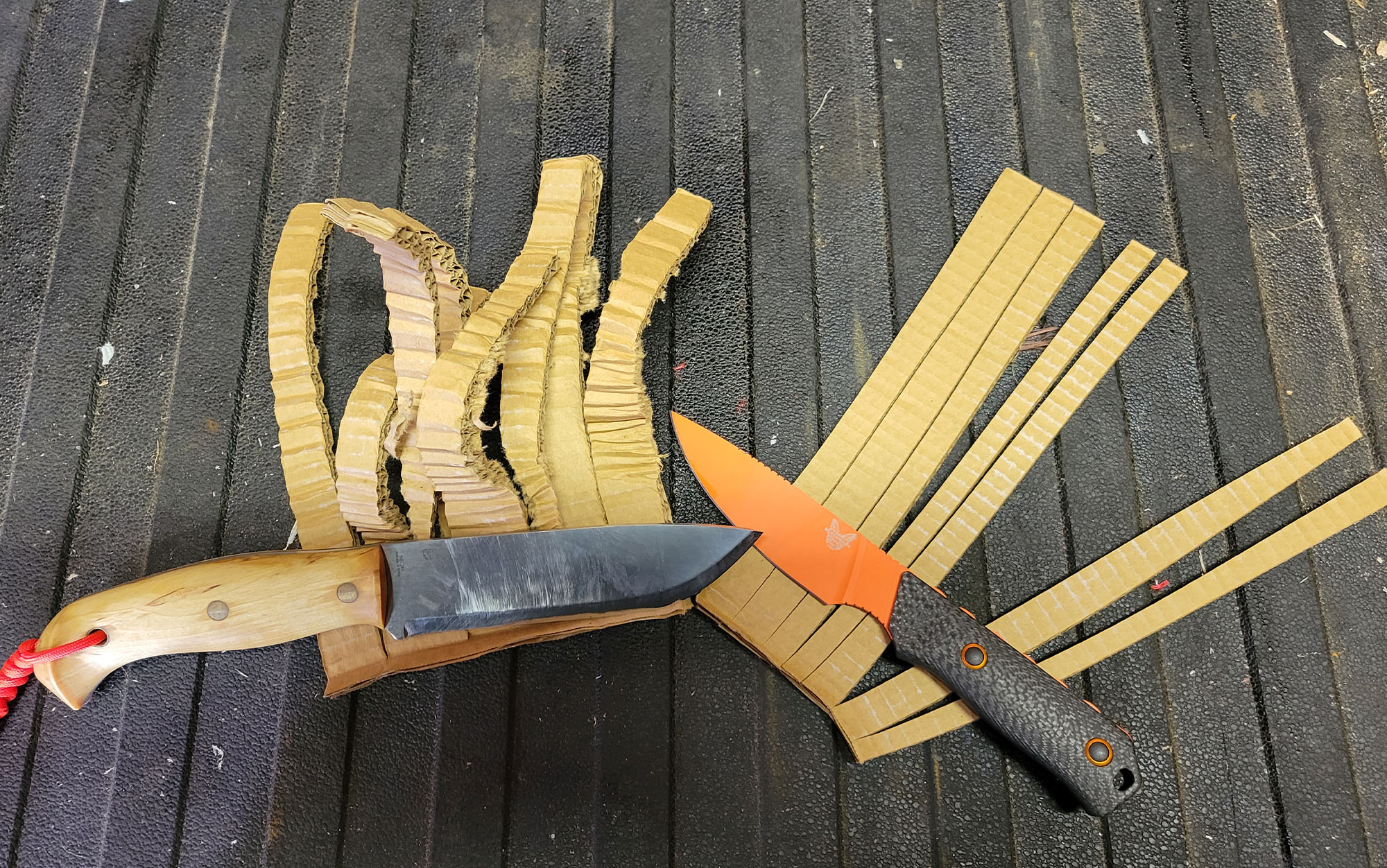
We did the following to test edge retention, ergonomics, blade geometry, and overall cutting performance:
- Rope Push Cuts: This involved no slicing, just straight down pressure on the knife, to see how many pieces each knife would cut through at once.
- Harness Cuts: Again, no slicing or pulling the knife through, just pressure with the knife at a slight angle.
- Leather Cuts: Push cuts on 3.25mm cowhide leather.
- Apple Slices: This test revealed a lot about blade geometry. Poor slicers would crack and split the apple, making it harder to cut.
- Cardboard: We cut 15 feet (15, 1-foot cuts) of double-layer cardboard that was 6.5mm thick.
- Tent Stakes: We carved tent stakes with a pointed end and a birds’ mouth notch.
- We made feathersticks to test each knife’s carving finesse.
- Batoning: For the larger, stronger knives, we tested how well they would baton through seasoned ash.
- Ferro Rod: We used the spine of the knife to scrape a ferrocerium rod to see how easy it would be to start a fire with the feathersticks we made.
These tests were done with the factory edges, and the knives were not sharpened in between tests. After all the tests were done, the knives were rated on how sharp they were after testing in relation to how sharp they started. I also took into consideration the comfort of the grip, and the quality/usefulness of the sheath, which will be in each review.
In the chart below, there are two types of ratings used. First, there are ratings for how much pressure was needed to make the cut, which range from no effort to heavy effort. There are also numbered ratings ranging from 0 (fail) to 10 (perfect).
| Knife | Feather- Stick | Notch | Baton | Ferro Rod | Edge Retention |
| Benchmade Adamas | 4 | 5 | 8 | 4 | 8 |
| Benchmade Anonimus | 6 | 8 | 6 | 8 Notch/ 6 Spine | 7 |
| Benchmade Raghorn | 6 | 7 | N/A | 7 | 8 |
| CRKT Minimalist | 3 | 5 | N/A | 8 | 6 prem.4 base |
| CRKT Razel Chisel | 6 | 5 | N/A | 0 | 4 |
| Gerber Stowe | 4 | 6 | N/A | 0 | 5 |
| Gerber Strongarm | 6 | 5 | 7 | 8 | 5 |
| Gerber Terracraft | 8 | 7 | 7 | 9 | 7 |
| Helle Nord | 7 | 8 | 8 | 9 | 6 |
| MKC Blackfoot 2.0 | 6 | 8 | N/A | 1 | 7 |
| MKC Stoned Goat | 6 | 7 | N/A | 2 | 7 |
| MKC Stonewall Skinner | 6 | 7 | 4 | 2 | 7 |
| MKC Super Cub | 6 | 8 | 4 | 1 | 7 |
Best Fixed Blade Knives: Reviews & Recommendations
Best Overall: Montana Knife Company Super Cub
Key Features
- Blade Length: 5.37 inches
- Overall Length: 9.87 inches
- Weight without Sheath: 6.0 ounces
- Steel: 52100
- Handle Material: G-10
- Sheath: Ambidextrous Multi-Position Kydex
- Finish: Parkerized Black
- Price: $325
Pros
- Comfortable in a variety of grips
- Strong enough to baton, yet still lightweight
- Big enough to handle larger tasks, but nimble enough for precise work
- Lifetime warranty
Cons
- Getting a Super Cub can be hard as they sell out fast
The MKC Super Cub performed very well in nearly every category, and all testers agreed that it just had a special quality that they couldn’t quite put their finger on. It was made to be a knife that could handle the toughest backcountry hunts where you may encounter more than just quartering and skinning game. It was made with thicker stock than other MKC blades for heavy camp use, and insurance if things don’t go as planned.
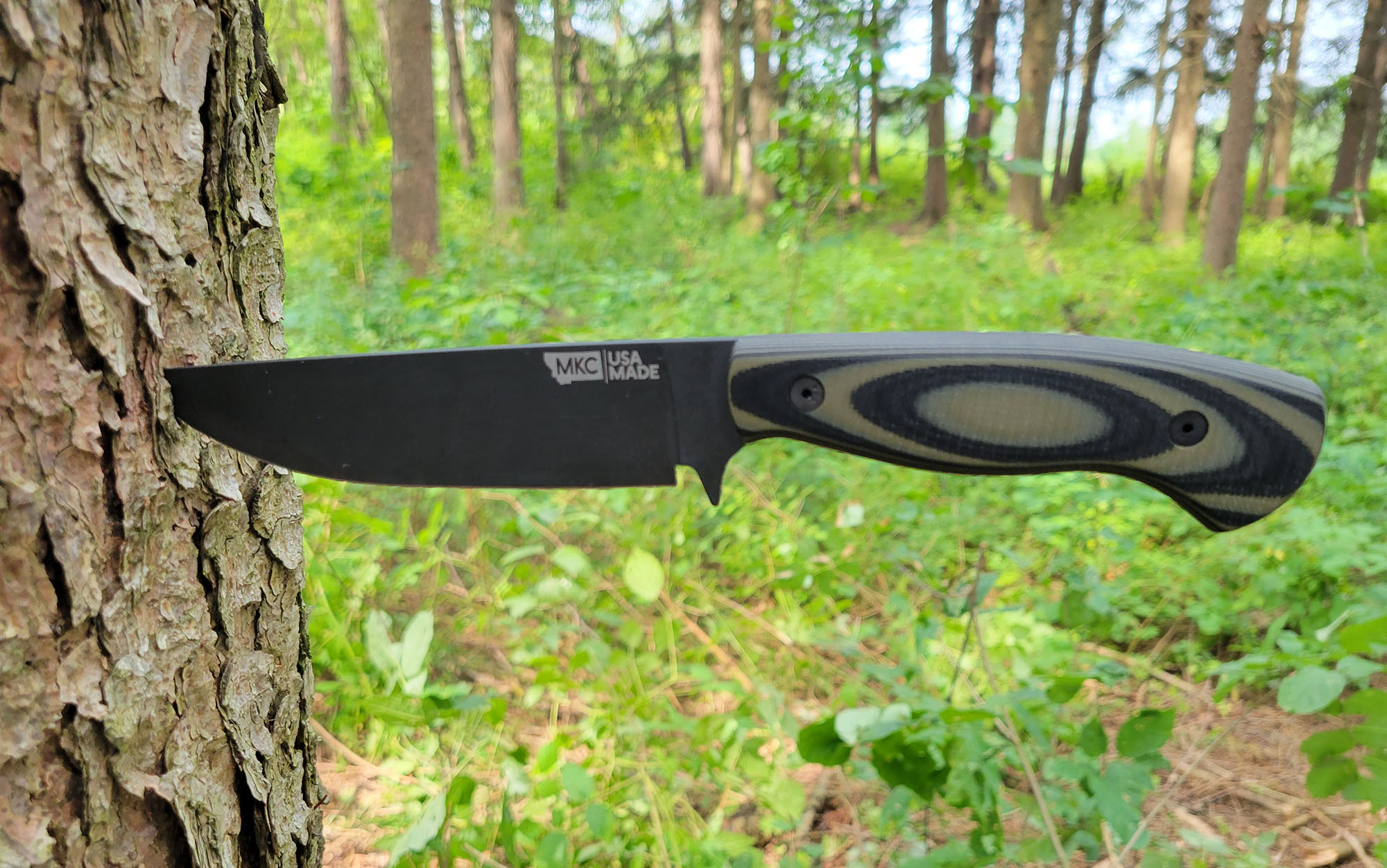
The extra length in the blade makes it useful for not only butchering, but processing firewood, and even de-limbing with some short chops. The 52100 ball bearing steel holds an edge well, while still being very easy to sharpen and hone. A few passes on a strop brings the knife back up to top performance. On top of the very solid test scores, and objective performance of the knife, the Super Cub just seems to possess something more, something not measurable. It exudes quality and capability, and just feels kind of special.
That “X” factor is part of what pushed the Super Cub to the overall top spot. One of the few places this knife was a little short was on firemaking. There are no 90 degree edges anywhere which means no striking a ferro rod. But, that’s only a problem if you use a ferro rod to make fires. If you’re looking for a well-built, tough blade that will get the job done for years to come, consider the Montana Knife Company Super Cub.
Most Versatile: Benchmade Anonimus
Key Features
- Blade Length: 5 inches
- Overall Length: 9.83 inches
- Weight without Sheath: 5.9 ounces
- Steel: CPM Cru-Wear
- Handle Material: Textured G-10
- Sheath: Ambidextrous Kydex
- Finish: Cerakote Gray
- Price: $279
Pros
- Well suited to nearly everything a knife is used for
- Comfortable and roomy grip that can fit even the biggest hands
- High Saber grind for added strength
- Cru-Wear Steel an excellent blend of toughness and edge retention
Cons
- A little stiffer retention on the sheath would be nice
The Anonimus performed near the top in every category, and if you needed one knife to do everything from firemaking to hunting to camping and bushcraft, the Anonimus would be my choice. It may not be the best hunting knife, or the best bushcraft knife, but it can do both of those things well. It’s designed to do everything, and isn’t hyper focused in one area. Most of the time, products like that end up being barely mediocre at everything, but the Anonimus is one of the few that hits a golden balance, and performs very well in many areas.
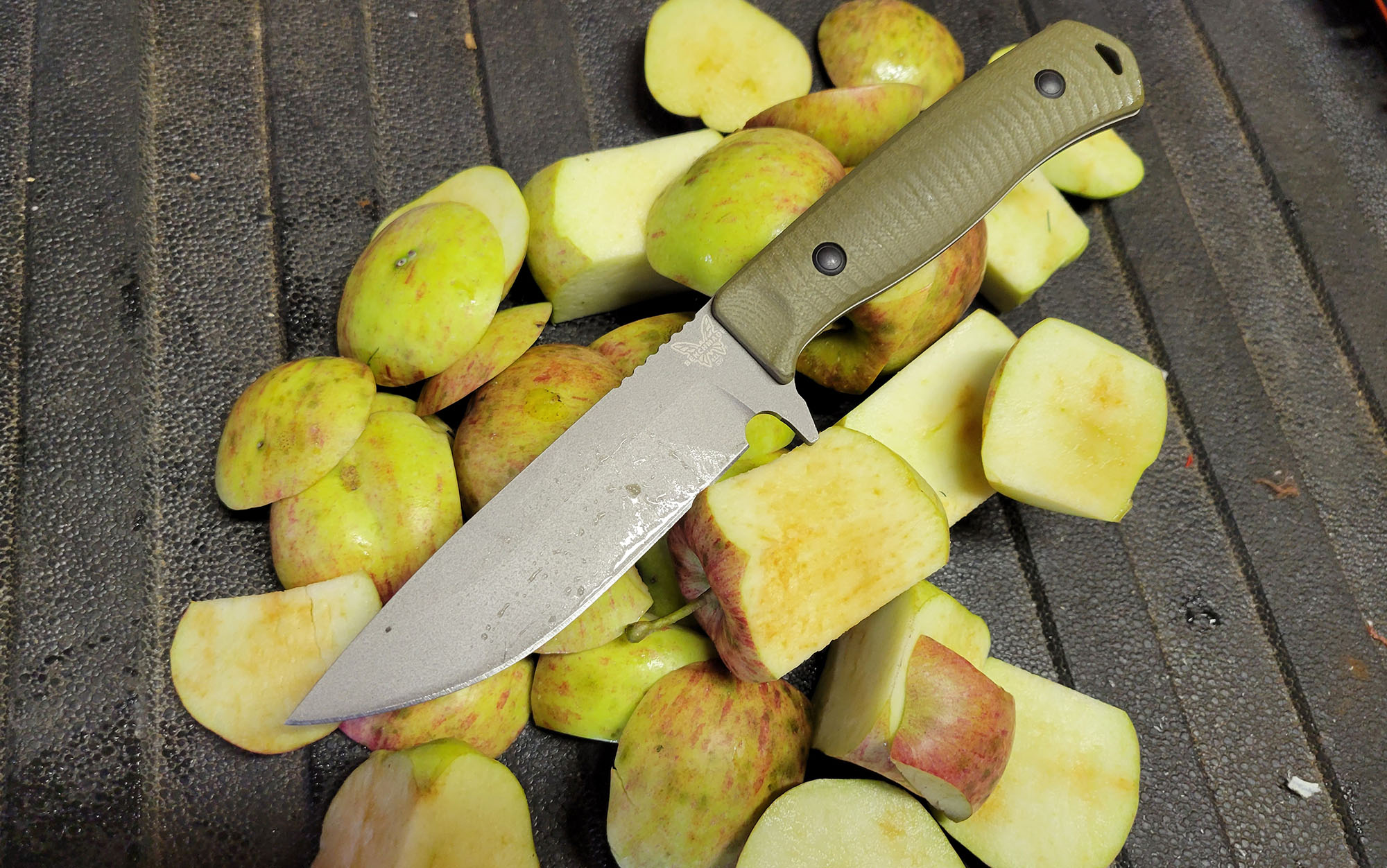
It manages to stay relatively light for backpack hunting, and yet retain enough strength to baton without a worry due to the saber grind and excellent blade steel. The finger guard (which could be a little shorter) keeps the user safe during heavy use, and the sharpening choil pulls double-duty as a sharpened notch for striking a fire steel. The Anonimus has a great blade shape for hunting, a great grind for doing camp work, an ambidextrous sheath for my fellow lefties, an ergonomic grip, and a quality coating to prevent rust. The thoughtful design and material choices showed up in the cutting tests where the Anonimus consistently scored at or near the top. If you are the pragmatic type like me, and you are looking for one blade to rule them all, you would be hard pressed to beat the Anonimus.
Best Hunting Knife: Benchmade Raghorn
Key Features
- Blade Length: 4.125 inches
- Overall Length: 8.88 inches
- Weight without Sheath: 3.5 ounces
- Steel: CPM Cru-Wear
- Handle Material: Carbon Fiber
- Sheath: Boltaron
- Finish: Orange Cerakote
- Price: $378
Pros
- Select Edge technology made this the sharpest blade from the factory by a solid margin
- Super light for long range and high-altitude hunts
- Blaze orange sheath and blade make it hard to lose and easy to find
- Comfortable grip and nimble blade
Cons
- Expensive
- Sheath has no clip or loop, and could be a little tighter retention
The Benchmade Raghorn costs more than some entry level hunting rifles, but the cutting performance is elite. Benchmade offers Select Edge on some of its models, and this blade came with a near mirror polished edge that was whittling hair when I took it out of the box. For the harness cut test, it blew through one layer like it wasn’t there, so I sliced through a spot with four layers stitched together, and it sliced a curved cut through that section more easily than most knives went through one layer. I used the Raghorn to debone a whitetail’s front shoulder with ease. While butchering the shoulder, the grip was comfortable, and the jimping gave excellent traction.

The test group fought over who got to do the cut tests with the Raghorn because it just melted through everything. The Raghorn is ultralight, and would be the perfect companion on a backpacking hunt where weight matters. The Cru-Wear steel has very good edge retention, and since it comes so sharp, you have a long way to go before it will need a touch-up. However, because of the thin blade, this is not a camping or bushcraft knife. This is a purebred, lightweight hunting knife. Amazing on game for slicing hide, deboning, and butchering, but not made for heavy-duty tasks.
The only drawback for the Raghorn (other than the price) was the sheath. It comes with holes so that something like an Ulti-Clip could be mounted, and it comes with slots for mounting on Molle webbing, but there is no belt loop or clip included. For the price, I would have expected something to give you a carry option other than your pack or your kill kit. That being said, this knife will reside in my hunting pack permanently. If you are looking for the ultimate fixed blade for hunting, look no further than the Benchmade Raghorn.
Best EDC: CRKT Minimalist Drop Point
Key Features
- Blade Length: 2.16 inches
- Overall Length: 5.25 inches
- Weight without Sheath: 1.7 ounces
- Steel: 5Cr15MoV (Base) and 154CM (Premium)
- Handle Material: G-10 or Micarta
- Sheath: Molded Zytel with lanyard and clip or Leather
- Finish: Black Stonewash or Satin
- Price: $30 (Base) and $99 (Premium)
Pros
- Compact size legal almost anywhere
- Handle lanyard aids in grip and comfort
- Slices well for light tasks
- Neck lanyard makes for easy carry and concealment
Cons
- Short blade limits some cuts
The Minimalist was the most compact and easiest to carry fixed blade in the test, and despite its small size proved useful in EDC tasks. Its comfortable grip pushed it to the top for EDC blades. We tested both the Base and Premium model for the CRKT Minimalist, and both did well. The premium version comes with a leather sheath, micarta scales, and 154CM steel, which is a big jump in steel quality. Other than materials used, they are the same knife.
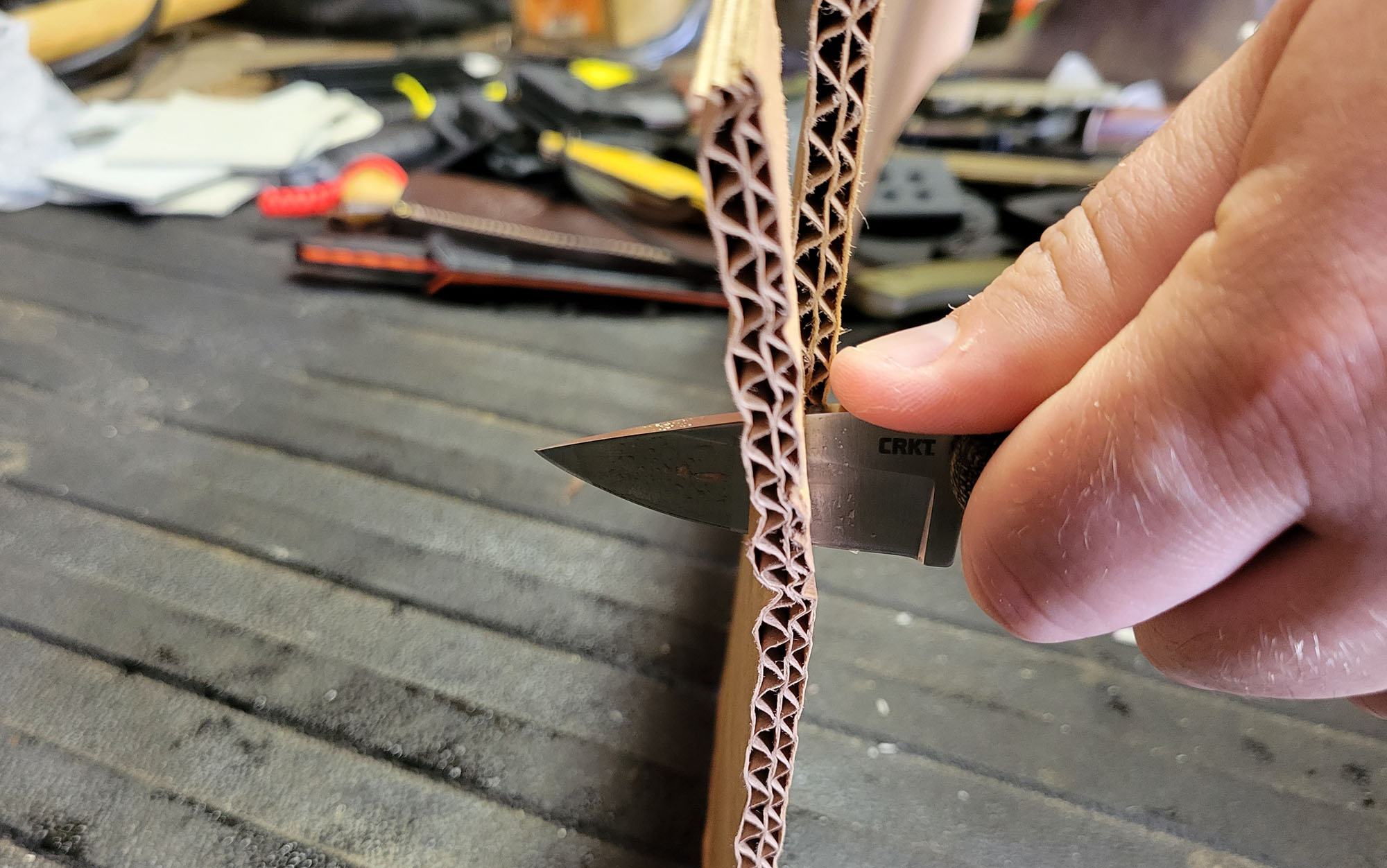
Oddly, everyone preferred the usefulness of the Zytel sheath with the option of putting on the pocket clip over the leather sheath of the premium version. Having a knife this small on your belt with the leather sheath just didn’t feel right. However, as a neck knife, or clipped in the pocket, the Minimalist was excellent. Easy to grab for quick cuts, and comfortable while cutting.
The comfort is actually what pushed this to the top for the EDC category. It beat out the Stowe and Razel Chisel because it had a better grip. While there are only three finger grooves, (that seemed to fit nearly all sizes of hands) the braided lanyard gives your palm and last finger something to hold onto, and provides a good feel in hand. The main reason to spend more for the Premium model would be for extended edge retention from the 154CM.
The Premium’s edge will last about three times longer between sharpening over the Base. Also, there are several blade shapes that can be had in the Minimalist if you aren’t a big fan of the classic drop point. There’s even a cleaver shaped version. Perhaps the biggest surprise was how well the Minimalist threw sparks from a ferro rod. It was in the top three out of all tested. Overall, the CRKT Minimalist is a great little back-up blade or easily concealable fixed blade that shines in day to day use.
Best for Bushcraft: Helle Nord
Key Features
- Blade Length: 5.75 inches
- Overall Length: 11.12 inches
- Weight without Sheath: 10.2 ounces
- Steel: 14C28N Sandvik
- Handle Material: Curly Birch with Brass Pins
- Sheath: Right Hand Leather Pouch Style
- Finish: Semi Mirrored
- Price: $250
Pros
- Large handle allows for choking up for control, or hanging back for some chopping
- Sharp spine easily makes tinder scrapings and throws huge sparks from a ferro rod
- Great retention in the sheath
- Longer blade can process large wood pieces
- Scandinavian grind is best for carving
Cons
- Stainless steel won’t throw sparks from a flint
The Nord’s great handle, beautiful sheath, and a razor-sharp Scandinavian grind on the blade helped it excel in our tests. Helle made this knife specifically for getting work done in the forest, and it shows.
The Helle Nord was the only knife in the test with a Scandinavian grind, and that made for good batoning/splitting, and excellent carving. While it’s the largest knife in the test, the thinner blade stock and perfectly contoured handle make this knife very controllable and a joy to use. The same Scandi grind that is great for carving does hinder it in tasks like slicing carboard and food prep. This wouldn’t be something I’d choose to go hunting with, though it could get the job done. But if I’m building a shelter or making lots of fires or carving, the Nord would be my choice.
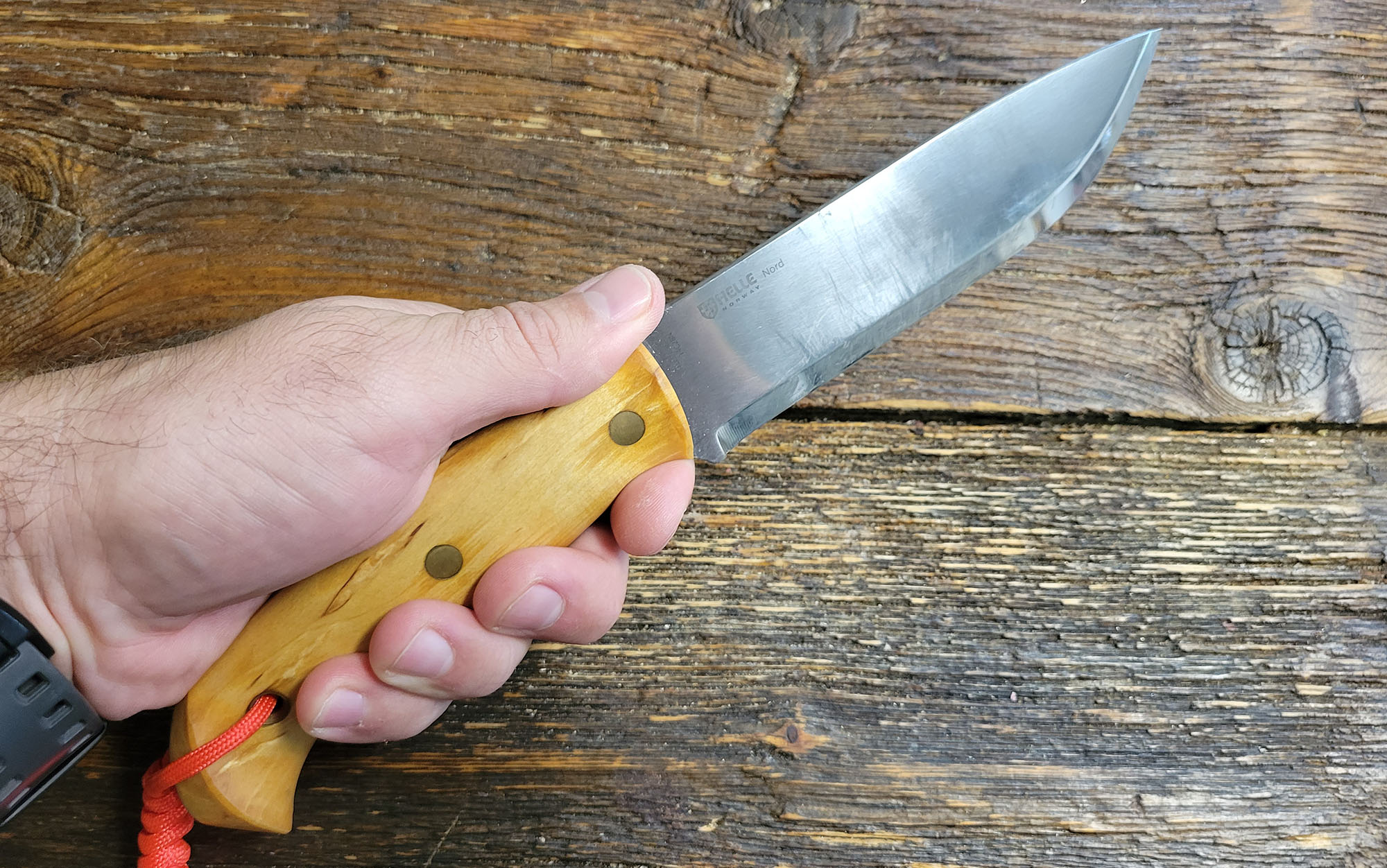
Aside from being a great tool, the Nord is also a beautiful blade with the curly Birch handle scales and decorated leather sheath. Quality components and quality craftsmanship show in this knife. The swell at the back of the handle provides good security if you need to do some swinging with it, but don’t expect it to work like one of the best camping axes.
The ⅛-inch thick blade makes it very controllable, but it doesn’t have enough forward weight for serious chopping. The spine is a sharp, 90 degrees all the way to the tip which makes fire prep and striking a ferro rod easy. You actually have to go a little lighter so you don’t peel off too much of the ferro rod. If you’re looking for a quality Bushcraft blade, take a look at the Helle Nord. Also, if you’re looking for a bushcraft style blade that isn’t quite as big, keep reading and look into the Gerber Terracraft, which almost took this category.
Best for Survival: Gerber StrongArm
Key Features
- Blade Length: 4.875 inches
- Overall Length: 9.75 inches
- Weight without Sheath: 7.1 ounces
- Steel: 420HC
- Handle Material: Rubberized handle
- Sheath: Ambidextrous MOLLE compatible modular sheath
- Finish: Black Coated
- Price: $89
Pros
- Versatile sheath system
- Full tang extends back to pointed pommel
- Thicker blade feels nearly indestructible
- Easy to sharpen
Cons
- Thicker blade sacrifices slicing
The Gerber StrongArm is a tough blade that can handle regular cutting, and also take actual abuse, which makes it perfect for emergency situations.
The Gerber StrongArm is designed for military use, which makes it great for a bug out bag or as a survival knife. Vehicles break down or crash in the middle of nowhere, people get lost, and natural disasters happen. The StrongArm is almost perfectly suited for those times, which usually last 72 hours or less. The first feature that makes this knife perfect for an application like this is the sheath. It can be mounted to nearly anything, in any direction.
It’s MOLLE compatible for a pack, but it will also scout (horizontal) carry, run off your belt, or you can wear it on a drop leg mount. The pointed striking pommel can accept a lanyard, and be used for knocking out a window in the event of a crash. And if things are really bad, the blade is thick enough and the steel is tough enough to do some prying in a bad situation.
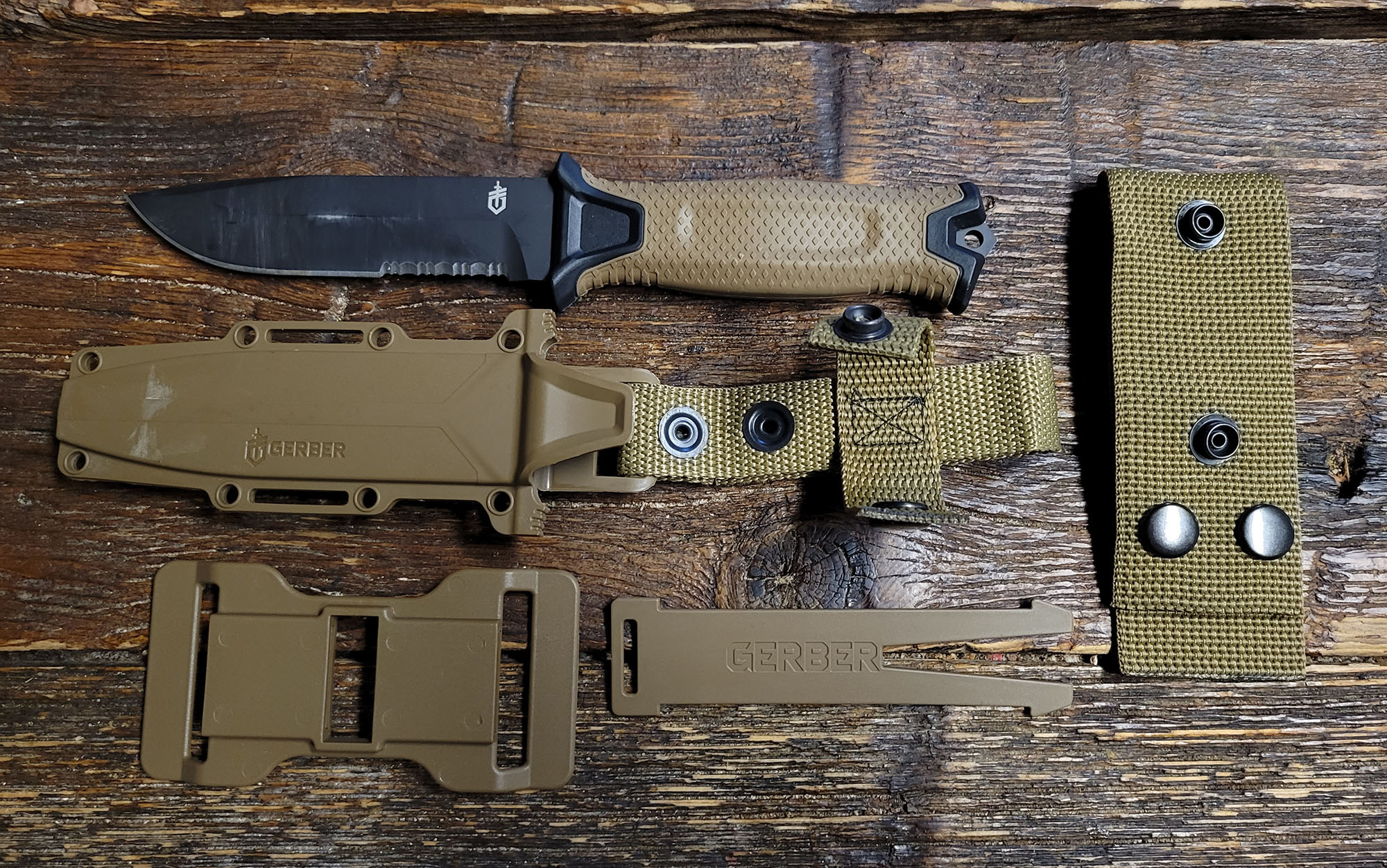
The StrongArm didn’t stand out in the cutting tests, but that’s mainly due to its steep edge geometry from the factory. It makes the edge tougher, but sacrifices cutting performance. After testing, I reprofiled the edge using one of the best knife sharpeners and the StrongArm performed much better in the same tests. The 420HC Steel doesn’t hold an edge that long, but it’s fairly easy to sharpen. A beefy blade, pointed pommel, grippy handle, and an excellent sheath system propelled the Gerber StongArm to the front of this test when it came to a tactical, emergency, and survival-focused fixed blade.
Best Ultralight: Montana Knife Company Stoned Goat
Key Features
- Blade Length: 3.75 inches
- Overall Length: 7.75 inches
- Weight without Sheath: 1.9 ounces (less if you remove the paracord wrap)
- Steel: 52100 Carbon Steel
- Sheath: Ambidextrous, Multi Position Kydex
- Finish: Parkerized Black
- Price: $225
- Handle Material: Paracord Wrap
Pros
- Excellent blade shape for skinning and processing game
- Sheath can be mounted just about anywhere on your belt or pack
- Excellent slicer
- Paracord can be removed and used
Cons
- Skeletonized handle and thin blade stock means low weight, but also reduced strength
Everyone that picked up the Stoned Goat during testing had the same reaction: Raised eyebrows followed by a surprised “wow.” This knife feels impossibly light. You wonder at first if it’s actually made of steel or some futuristic 3D printing material. It’s that light. If you are in the ultralight backpacking crowd (as I was for several years) or you want to climb the highest peaks in search of the sheep or elk of a lifetime and you’re counting every ounce, this is your knife. Part of the mindset for ultralight backpacking and hunting is multi-use items, and the Stoned Goat is one of them. The paracord wrap on the handle can be removed and you can use the 7-plus feet of paracord to make a repair, set up a tarp shelter, or strap game to your pack.
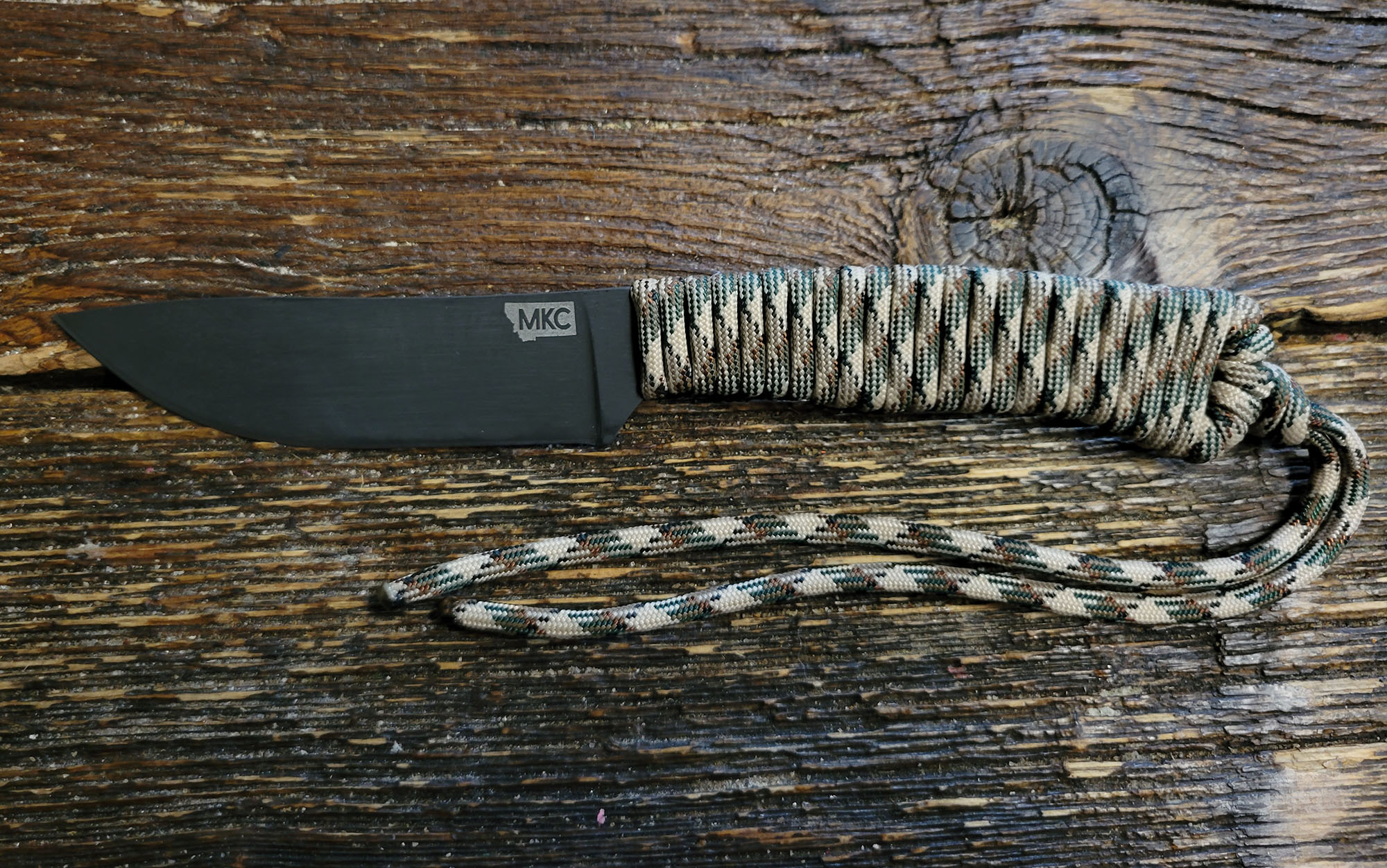
The Stoned Goat gets its name from two other knives that MKC makes: The Stonewall Skinner and the Speedgoat. Based on customer feedback, MKC borrowed the blade shape from the Stonewall Skinner, and the ultralight construction and size of the Speedgoat to give us the Stoned Goat. The blade is quite thin (I measured mine at a mere .093 inches) which makes it a great slicer, and the skeletonized handle sheds even more weight.
You can easily flex the knife side to side with a little pressure. The 52100 steel is frequently used in springs, which makes it tough and flexible. This isn’t a beefy beater blade that can pry and split wood. This is a no-compromise ultralight fixed blade. As a bonus, MKC has their “Generations Promise” which offers free lifetime sharpening and maintenance. So, if you use the paracord on the handle or dull your knife, you can send it in and get it rewrapped and sharpened at no charge.
Best for Meat Processing: Montana Knife Company Stonewall Skinner
Key Features
- Blade Length: 4.75 inches
- Overall Length: 9.25 inches
- Weight without Sheath: 5.45 ounces
- Steel: 52100 Carbon Steel
- Handle Material: G-10
- Sheath: Ambidextrous, Multi Position Kydex
- Finish: Parkerized Black
- Price: $325
Pros
- Excellent ergonomics and blade shape
- Strong enough for camp chores, but thin enough to make precision cuts
- Excellent blade retention and sheath design
- Easy to sharpen
Cons
As an all-purpose knife, the Stonewall Skinner was my number two choice, and it was my number two choice as a pure hunting knife as well. But, as a meat carver and skinner, it’s number one. It carved up a whitetail rear quarter with ease. The fine point makes precise cuts, and the sweeping belly is optimal for peeling away hide or silver skin from meat. The textured G-10 handle is comfortable and fit all of the testers’ hands, who wear glove sizes from medium to 2XL.
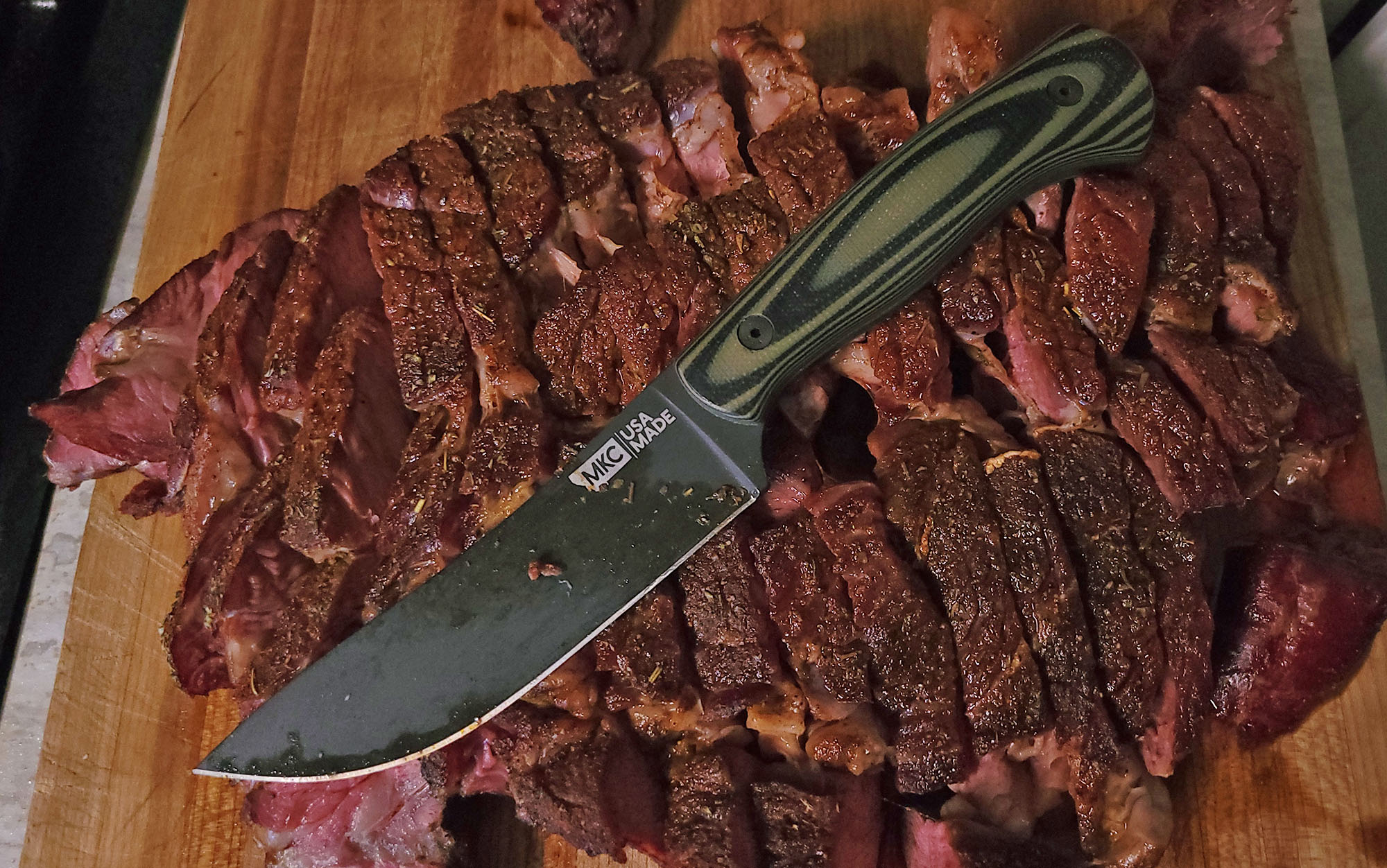
This knife would also feel right at home in the kitchen for everyday cooking. The full flat grind and sharp factory edge allowed it to glide through the cutting tests and through game meat alike. As a hunting knife, this isn’t as light as others, but that also allows it to do more around camp, giving it more versatility as a do-all blade. If you want to make quick work of skinning in the field, and fancy yourself the camp chef, the MKC Stonewall Skinner would be a great choice for you.
CRKT Razel Chisel
Key Features
- Blade Length: 2.0 inches
- Overall Length: 5.31 inches
- Weight without Sheath: 3.0 ounces
- Steel: 8Cr13MoV
- Handle Material: None
- Sheath: Polymer
- Finish: Satin
- Price: $35
Pros
- Sheath designed for pocket carry so that it feels like a folding knife
- Chisel grind makes aggressive cuts
- Rounded spine makes a comfortable thumb rest
Cons
- Lack of handle material meant lack of comfort on heavier cutting jobs
The CRKT Razel Chisel was one of my favorites to carry for EDC. The sheath is designed to go in your pocket, and the clip is very familiar if you’re used to carrying a folding knife with a clip like I am. I found the non-traditional blade shape and grind to be useful for the majority of my EDC needs, but the lack of a pointed tip might be a deal breaker for some. The lack of a grip makes it really easy to carry, and it doesn’t take up hardly any pocket space, but it leaves a little to be desired if you have some heavier cutting tasks. And that comfort factor is the reason it didn’t take the top spot in the test.
Benchmade Fixed Adamas
Key Features
- Blade Length: 4.20 inches
- Overall Length: 9.17 inches
- Weight without Sheath: 5.66 ounces
- Steel: CPM Cru-Wear
- Handle Material: Bare or Paracord Wrap
- Sheath: Ambidextrous Polymer
- Finish: FDE Cerakote
- Price: $249
Pros
- Excellent blade retention in the sheath
- Cru-Wear steel is perfect for hard use applications
- Good blade shape for a variety of uses
- Comes with paracord to wrap the bare grip
Cons
- Even with paracord wrap, hard cutting is not comfortable
- Limited sheath configurations
The Fixed Adamas is a great tactical knife, and keeps a really low profile on a belt or chest rig. The Cru-Wear steel is tough and holds an edge. It won’t come out of the sheath unintentionally thanks to its adjustable retention and a secondary locking strap. We were surprised by how well the Adamas cut in our testing because it has a thicker blade stock than most of the others. What held the Adamas back from taking the top spot in this category was the handle.
I understand the reasoning for having it bare, and if you are always wearing gloves, and only using the knife for short periods of time, it’s not that big of a deal. But, even with the paracord wrap, the handle digs into the webbing between your thumb and index finger under pressure. There is plenty of grip, but it lacks comfort. The Adamas outperformed the Gerber in cutting testing, but the sheath is not nearly as versatile, and it wasn’t as comfortable. If you’re looking for a super tough blade with premium steel, superior cutting performance, and you can overlook the handle, the Adamas is an excellent fixed blade.
Gerber Terracraft
Key Features
- Blade Length: 3.9 inches
- Overall Length: 9.125 inches
- Weight without Sheath: 6.94 ounces
- Steel: CPM S30V
- Handle Material: G-10
- Sheath: Leather with retention strap
- Finish: Stonewash
- Price: $220
Pros
- Good sheath design retains blade, and protects the leather from damage
- 90 degree sharpened spine throws great sparks
- Premium steel
- Ergonomic grip
Cons
- Factory edge angle held back cutting performance
The Gerber Terracraft is a great knife, and, in my opinion, pretty much the perfect size for bushcrafting and camp chores. The grip is comfortable, the spine is super sharp, and it was tied for best ferro rod performance. The only criticism on the Terracraft is the factory edge angle—it’s just too steep. The Terracraft still cut and made good feathersticks and carved notches, but if the angle was 5 degrees shallower per side, this would have run away with the number one spot.
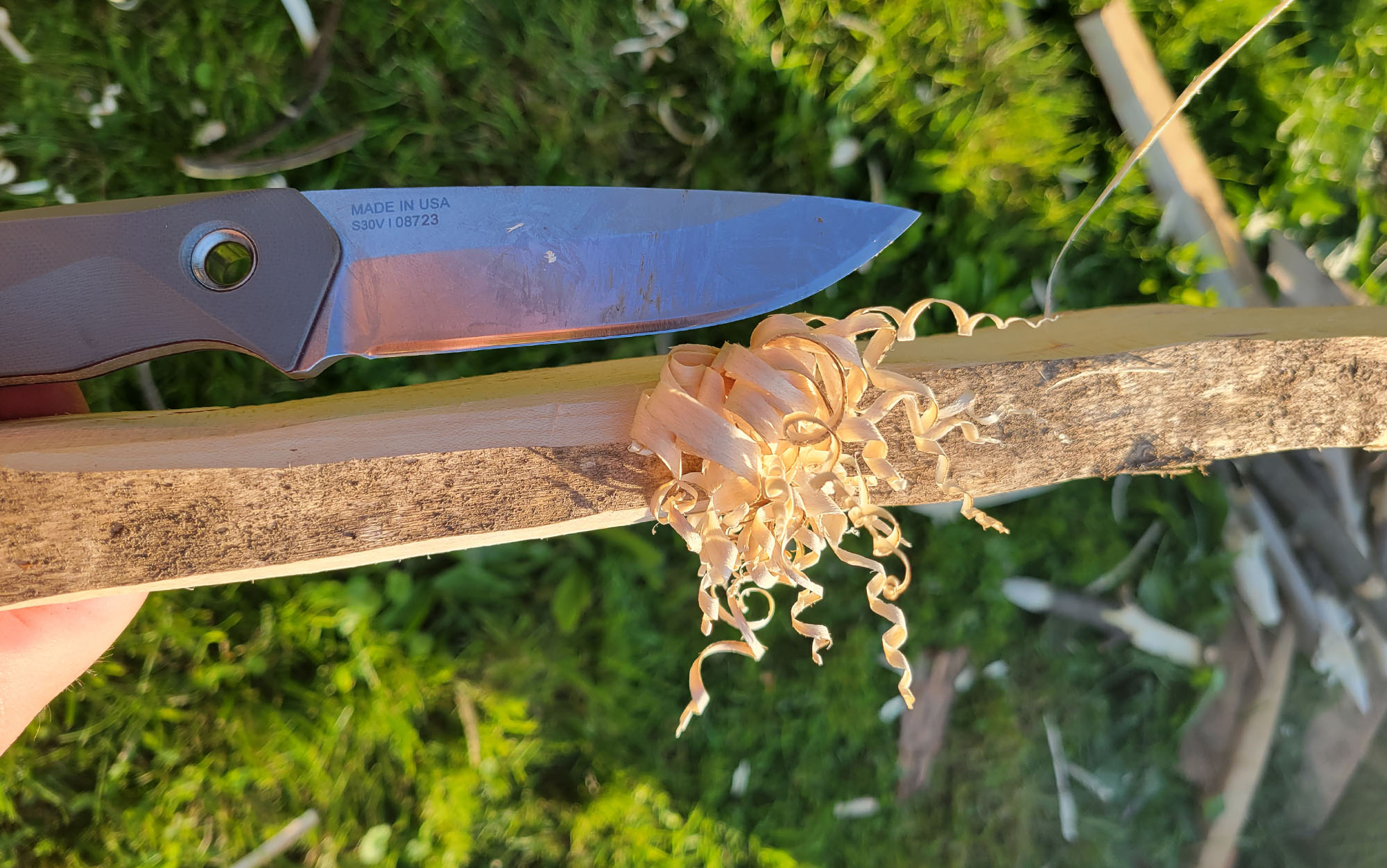
After testing was done, I reprofiled the edge with my Work Sharp, and the Terracraft was transformed from a good knife to a great knife. But, all the knives were judged based on how they left the factory. As it came, it was still a comfortable, capable bushcrafter with excellent steel, a lifetime warranty, and bombproof design. Also, the Terracraft has tons of custom colors and patterns and blade engravings and designs available from the factory if you want it to be unique. The Terracraft is a very solid choice, especially if you sharpen your own knives and can lower the angle just a bit.
Key Features
- Blade Length: 3.5 inches
- Overall Length: 7.75 inches
- Weight without Sheath: 3.6 ounces
- Steel: 52100 Carbon Steel
- Handle Material: G-10
- Sheath: Ambidextrous, Multi-Position Kydex
- Finish: Parkerized Black
- Price: $300
Pros
- Comfortable, ergonomic grip
- Fine point for caping
- Thin, slicey blade
- Generations Promise warranty/maintenance program
Cons
- Grip can be cramped for XL and above hands
The Blackfoot 2.0 is a great blade that the testers could see being an EDC knife and a hunting knife. I could only see myself using it for EDC in cooler months while wearing a hoodie or jacket. The clip makes the handle stick up above the belt line by about 4 inches, which gets in the way for me. However, one tester said it would be his choice for an EDC fixed blade.
We also had a tester that said it would be the perfect hunting knife size for his turkey and whitetail needs. The blade is certainly enough to get the job done on big game, and some people prefer a compact knife so they have perfect control, and if that’s where you land, this won’t disappoint on quality and capability. And if you like scout carry for EDC, this might be the perfect sheath and knife combo for you. Despite being a great fixed blade, the Blackfoot 2.0 was just outside my personal parameters to take first in those categories.
Gerber Stowe
Key Features
- Blade Length: 2.5 inches
- Overall Length: 6 inches
- Weight without Sheath: 2.6 ounces
- Steel: 440A
- Handle Material: Micarta
- Sheath: Reinforced leather with retention strap
- Finish: Stonewash
- Price: $40
Pros
- Sharp factory edge
- Reinforced retention strap springs out of the way when unsnapped
- Micarta scales provide good grip
- Lanyard hole available
Cons
- Sheath won’t hold the knife straight up
The Gerber Stowe has a nice, shallow edge angle that slices well despite its small size, and the large continuous belly makes it good for food prep. It performed well in the cutting tests for its size, and was a little uncomfortable during the cardboard cutting. What kept the Stowe out of the top spot for an EDC blade had nothing to do with the knife, but rather the sheath. For EDC purposes, the sheath is as important as the knife.
The Stowe sheath has a thin, flexible plastic liner sewn between the layers of leather that stiffen it and help it keep its shape. This layer is in the retention strap, and the portion of the sheath that holds the blade. However, the belt loop and short transition piece from the pouch to the belt loop has no reinforcement, which allows the knife to angle away from your body as the weight of the handle pulls down. It isn’t too bad when it’s on your belt and you’re walking around, but it makes getting the blade in and out a little tricky. It’s not a fatal flaw, but it did keep it from the top spot.
How to Choose a Fixed Blade Knife
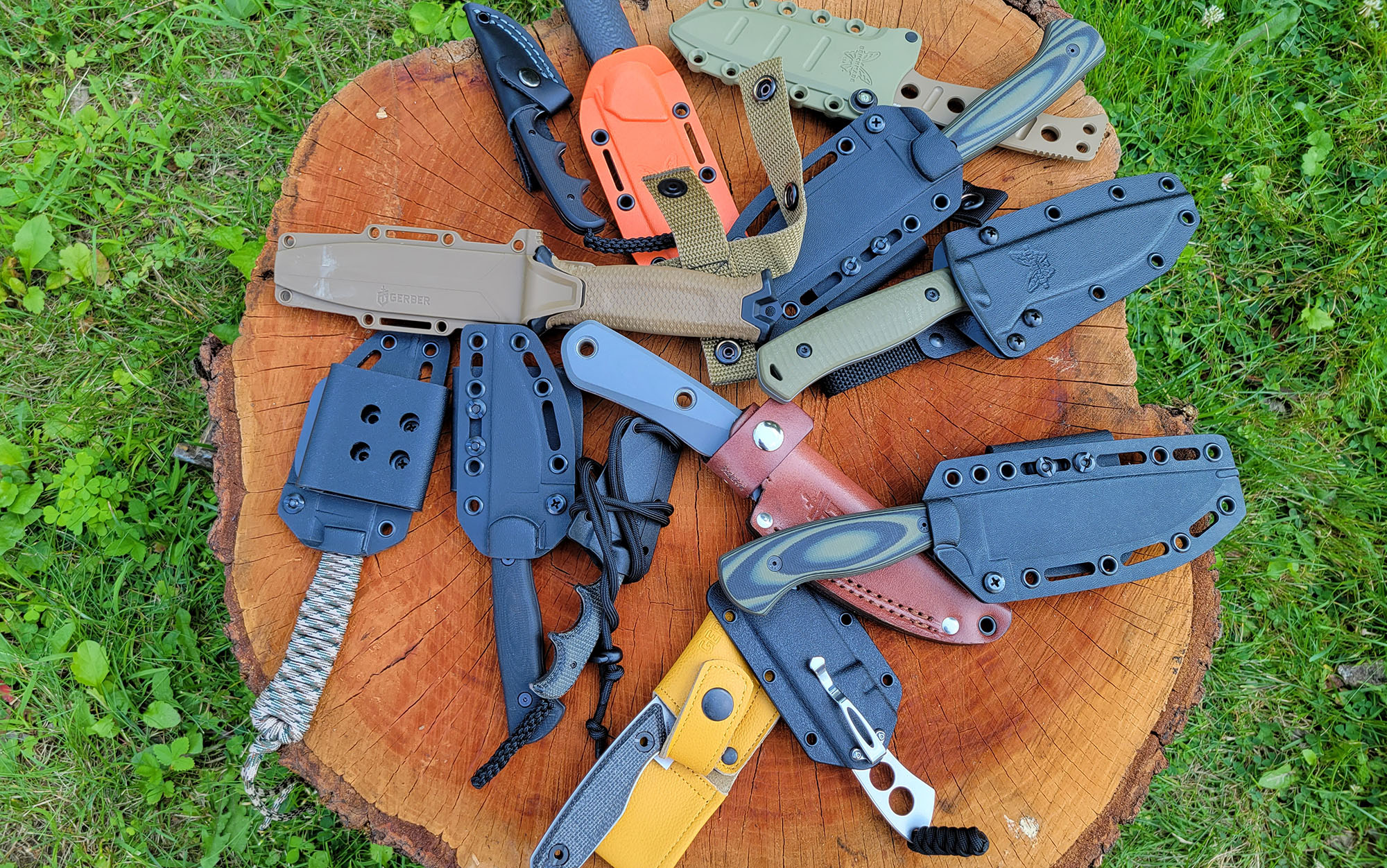
Grind
The best way to choose a fixed blade is by first determining what you are going to use it for. It’s always best to have the right tool for the job. And the first thing to check is the primary grind on the knife. A full flat grind, like that on the MKC knives, lends itself to slicing and cutting performance, with the drawback being that flat grinds have the most material removed which thins them, making them not as strong as other grinds.
Then there are Saber ground blades. Like that on the StrongArm, Anonimus, and several others. This is the most common grind for a knife. It retains the full thickness of the blade stock up near the spine, and the lower 2/3rds of the knife is ground down to the bevel. This grind gives a great balance of strength and cutting performance. Hollow grinds are similar, but they are concaved in instead of a flat bevel.
This makes for good slicing, but sacrifices strength down near the edge. Convex grinds are like flat ground but instead of a flat plane tapering down to the edge, they have a gently curving profile down to the edge. These are generally very strong and do well splitting wood as well. Finally, there are Scandinavian grinds (also known as zero grinds), like that on the Helle Nord. These tend to be very strong blades, and excellent carvers that can remove a lot of wood very fast. Scandi ground knives have the primary grind as the only grind. There is no small edge bevel, its ground right to zero. These grinds aren’t the best on game processing, but rule the roost for working with wood. Match your intended use to the type of grind that best suits it and then move on to materials.
Materials
The steel used can affect how the knife performs, and the handle scale material contributes to durability and grip. I could write a standalone article on choosing the best steel for your application, but I’ll try to keep it brief here. First, choose whether you want a stainless steel, or a carbon steel. If you don’t want to worry about rust, stainless is a good choice, but there are always trade-offs.
Stainless steels tend to take more time and effort to sharpen, but many have great edge retention. They also tend to be less tough than carbon steels, meaning the edge is more likely to chip rather than just roll. On the other hand, while carbon steel requires more maintenance to prevent rust, the steels tend to be easier to sharpen and tougher and more flexible. The reality is that most manufacturers are doing good heat treats these days, and can get solid performance out of the steels they use. There are lots of resources to see how steels compare, and a quick internet search will help you get the basics.
Handle materials are also important. Micarta and G-10 are my favorites because they resist chemicals and provide a solid grip, with micarta seemingly getting grippier when wet. Wood is good if it’s treated and maintained, and is generally a visually attractive option. Look for stabilized wood or burl woods as they are usually stronger.
Finally, there is sheath material. Leather is awesome when its done right, but when they get wet, they hold water longer. They can also loosen and lose retention over time and if they don’t have a retention strap, it may mean replacing the sheath. Kydex and Boltaron are very similar, and are essentially fancy plastics that mold well with heat and offer very good protection. A well molded Kydex sheath is hard to beat. But, be aware that not all companies nail Kydex. Along with these there are also plastic and polymer sheaths that function similarly, but are less rigid, and can’t be remolded with a heat gun or boiling water like Kydex and Boltaron.
Price
I was talking to a friend today who was complaining about how his folding knives are always falling apart after a couple weeks of landscaping duty. I showed him what I carry and told him that my knife cost me $170 when I bought it, but it’s almost 10 years old. I’ve beat the brakes off of it and it’s still ready to rock. Some of the knives on this list are very expensive. But, many come with lifetime sharpening and maintenance (Benchmade and MKC) and many others come with a lifetime warranty. So, you’re buying more than a knife.
After spending what I once thought to be a ridiculous amount of money on a knife, I was hooked, and I haven’t purchased any bargain basement knives since. I’ll be able to hand these quality pieces down to my children and grandchildren. However, if you can’t spend $200 on a fixed blade, there are some quality blades for well under $100, some of which are on this list. I recommend saving up a little longer, and buying the best that you can.
FAQs
Q: How do I take care of my fixed blade?
It depends on the blade. If it’s a bare carbon steel blade, clean it off when you’re done using it, and wipe on a thin layer of food grade mineral oil. If it’s coated, you might not have to do much at all other than keep the exposed edge clean and dry. Stainless knives require less work, usually just cleaning. As for keeping them sharp, there are loads of sharpeners and strops available to keep them in good working condition, or, if the manufacturer offers it, you can send it in and they will sharpen and clean it.
Q: Why do some knives cost so much more than others?
Some of the difference is in “free” services after the purchase such as sharpening and cleaning and repair. Some of the price difference comes down to where it was manufactured. American labor and manufacturing generally costs more than foreign labor. And some of the difference comes down to quality control, and cost of materials. Certain steels cost 10x what the inexpensive steels do. Lastly, the heat treatment and manufacturing processes are harder and more involved on some high-performance steels, which increases cost.
Final Thoughts on the Best Fixed Blade Knives
Testing these 13 fixed blades head to head showed what each is best at and where the tradeoffs lie. The good news is that the market is flooded with lots of great blades for just about every budget, and this group of knives proves that.

